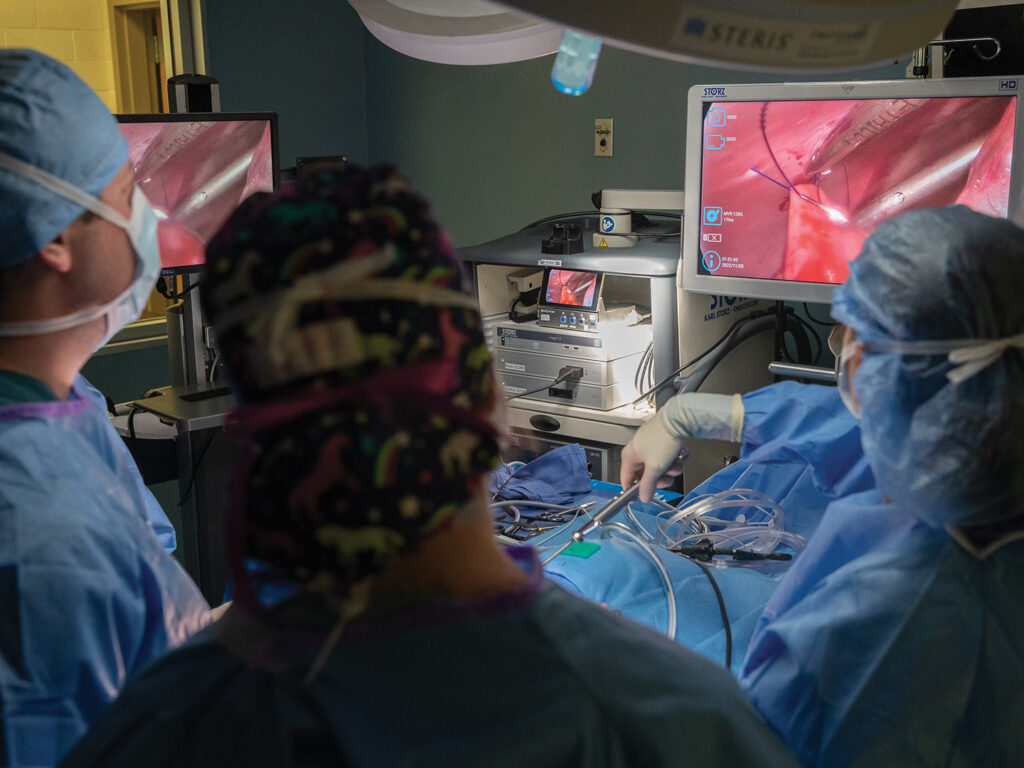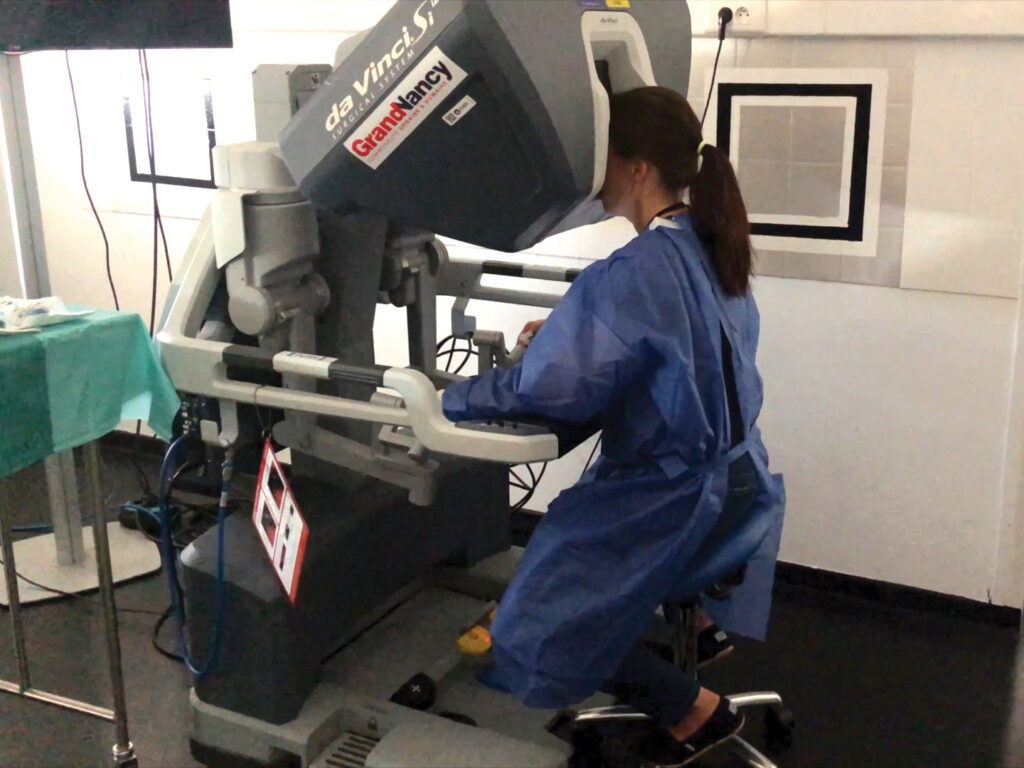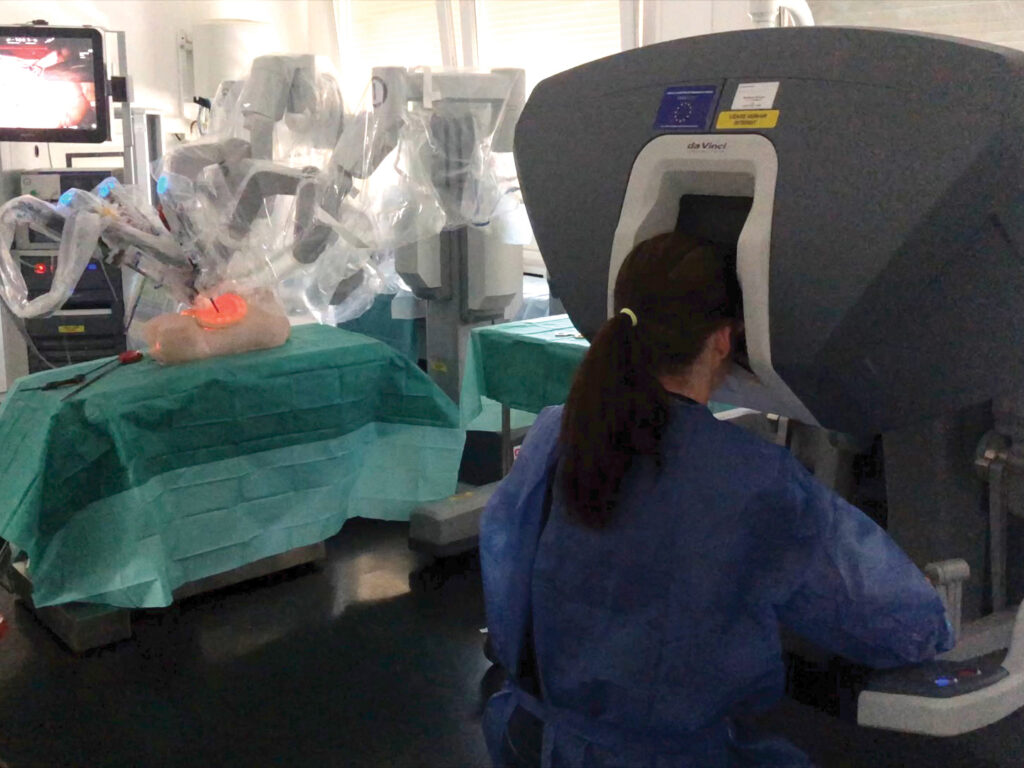VMBS Faculty Member One Of First Veterinarians To Train On New Robotic-Assisted Surgery System
Story by Rachel Knight, VMBS Communications

The introduction of endoscopy, a surgical procedure that uses cameras and instruments in a small incision rather than the large incisions required for open surgery, is one of the greatest successes in medical history. Before the introduction of endoscopy, large problems required large incisions.
Today, a few tiny openings paired with small cameras and rigid surgical tools are all that’s typically required for a surgeon to successfully perform most surgeries in human beings and many surgeries in animals.
While endoscopy is widely recognized as the top practice for many surgical procedures, medical and technological advancements aim to further improve endoscopic surgeries.
Dr. Kelley Thieman, the Nancy & Michael Shaw ‘68 Chair in the Texas A&M School of Veterinary Medicine & Biomedical Sciences’ (VMBS) Small Animal Clinical Sciences (VSCS) department, is among eight veterinarians who traveled to Nancy, France, in the summer of 2022 to train with the da Vinci Surgical System, robotic-assisted equipment that is on the cusp of endoscopic surgical advancements.
“Robotic-assisted surgery is very futuristic,” Thieman explained. “Veterinarians have seen more and more desire for minimally invasive procedures because it’s what we get as humans. Looking at ways to bring this tool into veterinary medicine is keeping up with the peak of what’s being offered to humans for surgery.
“Working with the da Vinci system was really cool. It’s a novelty in veterinary medicine, but it’s starting to become more common for human procedures,” Thieman said. “We were the first group of veterinarians to train with this equipment, and it was really neat to be a part of that group.
“I think we should work to offer surgical options in veterinary medicine that are offered in human medicine,” she said. “This training was a first step in doing that with robotic-assisted surgeries.”
Thieman, who practices soft tissue and minimally invasive surgery at the VMBS’ Small Animal Teaching Hospital (SATH), routinely performs laparoscopic surgeries, an endoscopic surgery performed in the abdomen.

While endoscopy ushered in a new era of minimally invasive surgery, requiring only a few small cuts to complete major surgeries, it also brought new limitations to a surgeon’s movement in the affected body cavity because traditional endoscopic equipment is limited to rigid movements.
Robotic-assisted endoscopic surgeries add the benefit of circular, wrist-like movements.
“Laparoscopically, stitching things is really difficult because you don’t have any wrist motion and that’s how we suture,” Thieman shared. “But with the robot, it is a lot easier because all of a sudden, you have the wrist motion. So it’s almost like tiny hands in there instead of the rigid instruments because the robot can move like a wrist would move.”
Minimally invasive procedures also have a smaller chance of surgical site infection than open procedures, Thieman pointed out.
In addition to the improved range of motion, the da Vinci system offers cameras with increased visibility, and the equipment filters out hand tremors to help the surgeon move each instrument with smoother precision.
“Your fingers get velcroed into place on two different hand controls. Then you begin and you’re in control of the instruments. What you see, of course, is the instrument in the patient, not your hands on the controls,” Thieman said. “It can pick up all of your little motions. There’s also a foot pedal that allows you to change between instruments and move your camera around.”
Robotic surgical systems like the da Vinci also improve visibility into the body cavity with high-resolution, 3D displays.
“The visualization is really good because you’re really close — it’s magnified and illuminated,” Thieman shared. “Visually, it’s almost like you’re standing inside the cavity.”
Thieman’s experience training with the da Vinci system concluded in just five days, but the experience working with the robotic-assisted surgical technology excited her about the future of veterinary medicine and the role the VMBS plays in developing that future.

She explained that while robotic-assisted surgical technology is more developed for humans, it’s still a novelty in the field of veterinary medicine.
The new, next-generation small animal teaching and research hospital currently being planned at the VMBS provides an opportunity to purchase robotic-assisted surgical equipment. Doing so would place Texas A&M faculty, researchers, clinicians, and students on the cusp of defining robotic-assisted surgical approaches in veterinary medicine.
It would also introduce new potential for collaboration with Texas A&M Health and other professional and academic units on campus.
“In human medicine, there’s a binder on the front of the machine that shows how to set up the equipment for human surgery,” Thieman said. “Veterinarians don’t have that. Our patients are a different shape than human patients. So finding those locations would be step one in introducing robotic-assisted surgeries to veterinary medicine.”
Writing the book on how to use systems like the da Vinci begins with access to the technology. The initial purchase of a da Vinci surgical system costs $2 million, while a training version of the system starts at about $200,000, Thieman said.
Opportunities to fund cutting-edge veterinary equipment like the da Vinci surgical system abound in the next-generation small animal teaching and research hospital fundraising campaign. Those interested in contributing to the cusp of veterinary surgical advancement can learn more about giving opportunities at tx.ag/NextGenVetHospital.
“I have an interest in minimally invasive surgery, and robotic-assisted surgery really pairs well with that because it enhances laparoscopic- or thoracoscopic (surgery in the chest)-type surgery where you’re doing surgery through keyhole incisions,” Thieman said. “To be able to offer our clients and our patients what is being offered to human patients is important, and robotic-assisted surgery is the next step in that.”
###
Note: This story originally appeared in the Winter 2023 edition of VMBS Today.
For more information about the Texas A&M College of Veterinary Medicine & Biomedical Sciences, please visit our website at vetmed.tamu.edu or join us on Facebook, Instagram, and Twitter.
Contact Information: Jennifer Gauntt, Director of VMBS Communications, Texas A&M College of Veterinary Medicine & Biomedical Sciences; jgauntt@cvm.tamu.edu; 979-862-4216


